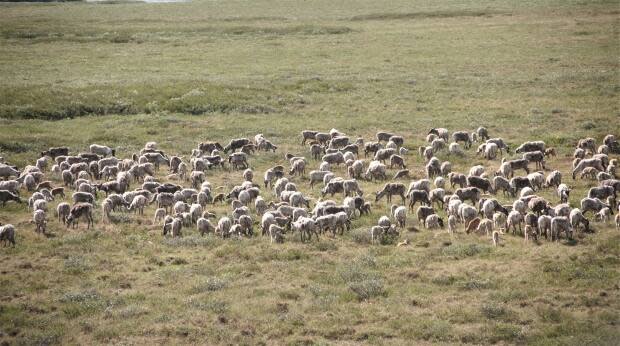Resource board calls on N.W.T. to end controversial aerial wolf cull
The board responsible for managing the caribou herds of the eastern N.W.T. is recommending the territorial government end one of its most controversial programs aimed at preventing their decline.
The Wekʼèezhìi Renewable Resources Board (WRRB) issued their final recommendations Friday on a one-year wolf cull pilot program that saw the government hire marksmen to shoot wolves from helicopters, in an effort to decrease their impact on the population of two key caribou herds.
The Bathurst and Bluenose-East caribou, of central importance to Indigenous communities across the eastern and central N.W.T., have declined in numbers over recent years to the point that hunting from the Bathurst herd is prohibited, and tags for the Bluenose-East herd are severely limited.
The final report does not question the need for conservation measures, including the hunting of wolves, which are each estimated to consume between 23 and 29 caribou per year.
It does, however, recommend that the government abandon the aerial cull program, the most effective part of the cull, in favour of more grassroots investment in local hunters.
"The WRRB urged the [territorial and Tłı̨chǫ governments] to proceed with the ground-based harvest … with the addition of harvesters supports, including ɂekwǫ̀ [caribou] and dìga [wolf]distribution information, gas caching, and/or bait stations," the summary to the final report reads.
The current program offers financial incentives for delivering wolf carcasses to the Department of Environment and Natural Resources, but offers few other supports to hunters, who often must travel exceptionally long distances in pursuit of the animals.
In an email, the department said they have been "fully engaged" throughout the board's review and would accept or reject the recommendations in a response to be issued within 42 days.
The statement said it "will consider the recommendation to discontinue aerial wolf removals and increase resources for the ground-based harvest as part of its review."
Gov't fails to collect data on whether cull is effective
A theme of the report is the inadequacy of the territorial government's data and the lack of indicators to show whether the cull is effective.
Since 2010, the WRRB has been calling on the government to improve its data on wolf populations affecting the herds.
But the report notes the cull was actually preceded by a lapse in data collection, and efforts to determine a baseline population of wolves were "not sustained."
The report goes on to document substantial disagreements among those involved with the cull about both the size of the wolf population and whether it is decreasing or increasing in key areas.

The "controversial" nature of the wolf cull meant the board was left "anxious to see clearly stated goals and objectives to justify the levels of dìga removals," the report states.
But in its submissions to the board, the territorial government has been reluctant to tie the rate of adult caribou survival — a key benchmark for conservation — to the effectiveness of the wolf cull. Data presented in October suggested survival rates were already above 90 per cent, "as high as is reasonably possible."
Instead, the board was asked to wait for the results of a five-year review at the end of the project, which they say "may be too late if the risks of removing too few or too many dìga are not anticipated."
The cull's aim, it reads, "is to halt the decline and promote recovery of ɂekwǫ̀; yet there is no scenario in which improving ɂekwǫ̀ vital rates would cause … [a] pause or reduce operations."
A spokesperson for Environment and Natural Resources wrote that "the effectiveness of the program will be measured primarily by the number of wolves removed and the size of the herds."
To assess if the culled wolves played a role in the decline of the herds, data is also collected on their diet, health and movements, which are used to "assign" them to a particular herd.
In their report, the WRRB took issue with this method, which it called "partially adequate." It said the territory is not providing specific enough data on the wolves' location, especially in areas where multiple herds overlap, and suggested it may not be the best way of estimating the effectiveness of the culls.
But the territorial government says it is "using the best available scientific, local and traditional knowledge from a range of sources to guide its work, and will continue to explore new information as it becomes available."
Efficacy of cull in question
The aerial cull was introduced in the spring of last year as part of a broad effort to prevent the decline of the Bathurst and Bluenose-East caribou herds.
A five-year plan which included the aerial cull aimed to reduce the wolf population in the herd's range by as much as 80 per cent. Packs would be killed from helicopters only if local hunters failed to cull enough wolves from the herd.
But experts have at times called the efficacy of the N.W.T.'s wolf cull into question. Wildlife biologists called the cull a politically convenient "distraction" and a "placebo", and said its impacts would be minimal.
Many point to increased development near caribou calving grounds and along the herds' range, including a $1.1 billion all-season road greenlit by the territorial government in the fall, as a more significant contributor to their decline.
The Łutsel K'e Dene First Nation, which submitted a letter to the board, called the cull "inhumane and unnecessary" and said wolves were "respected co-dependents of caribou."
"Multiple public and participant comments criticized the [aerial cull's] ineffectiveness and inhumaneness," the board's report notes.
A Change.org petition against the cull has received nearly 46,000 signatures in two months.
The cost of the aerial cull has also been high — more than $320,000 to kill just 36 wolves last year. That compares with just $58,400 spent on the ground harvest incentives and support recommended by the WRRB.

